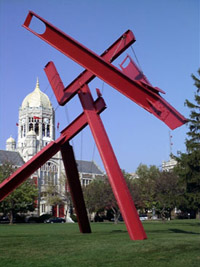
 Mark di Suvero (American, b. 1933)
Mark di Suvero (American, b. 1933)
Victor’s Lament, 1969-70
Steel I beams
With a broad knowledge of art history and a profound sense of aesthetics, Mark di Suvero produces sculptures that incorporate the lyrical beauty of motion and the heroic nature of Abstract Expressionism. Di Suvero’s abstractions capture the renewed spirit of American art in the post-war era.
Born in 1933, Mark di Suvero matured as an artist during arguably the most progressive period for American sculpture. In the late 1950s, after studying philosophy at the University of California at Berkeley, di Suvero relocated to New York City and created pieces which bridged the gap between the metal drawings of Abstract Expressionism and the straightforward cubes of Minimalism. Di Suvero’s pieces, while closely associated with architectural construction, engineering, and industry, relate to the emphatic gestural paintings of Jackson Pollock and Franz Kline. Di Suvero’s constructions also reference the playful movement of Alexander Calder’s mobiles.
In addition to his familiarity with works by other artists, di Suvero’s most significant artistic contributions derived from the manner in which he broke from tradition. He moved beyond traditional wood carving and embraced the materials, methods and progressive spirit of the modern age. Innovative technology, factory inspired tools, and underutilized materials offered new options for sculptural expression after World War II and as a result, di Suvero pioneered the art of Assemblage.
As an assemblage artist, di Suvero’s direct employment of non-traditional materials such as rough planks, steel rods, chains, girders, tires, ladders, and railroad ties became commonplace in the art world. Such unexplored sculptural materials and found objects became a mainstay for di Suvero’s post-war assemblages including Barrell 1959 (destroyed), Hankchampion 1960 (Whitney Museum of American Art), and Ladder piece 1961-62 (Museum of Modern Art). Di Suvero uses cranes, pulleys, lifts and other heavy equipment to assemble his large public monuments and works directly to design the pieces without the aid of extensive plans or preliminary drawings.
These elements make di Suvero’s large-scale structures simultaneously ominous and inviting. Di Suvero’s aesthetic interests prove evident in the steel I-beam structure Victor’s Lament (1969-70), which has become a focal point of the Muhlenberg College campus. The complex pulley system and steel I-beams of Victor’s Lament have provided the Lehigh Valley with a work that is contextually appropriate for the home of America’s steel industry. Today, Victor’s Lament takes its rightful place as an undisputed Lehigh Valley landmark as well as a major icon of twentieth-century American sculpture.
All art images and content are the property of Martin Art Gallery, Muhlenberg College, Allentown, PA. Any reproduction or distribution of this material without the expressed, written consent of the Martin Art Gallery is prohibited and a violation of federal law. All rights reserved.
